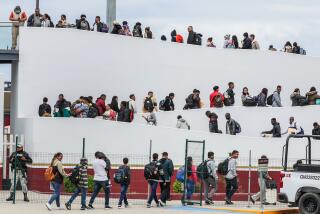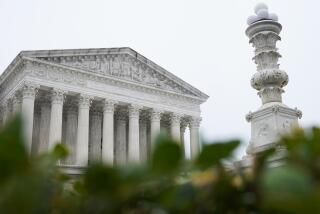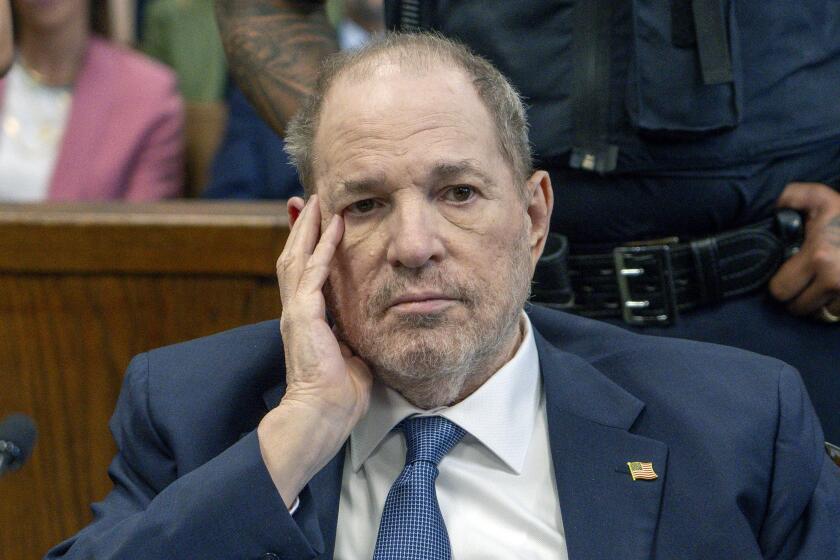Unrest in Occupied Areas Evolves Into New Pattern
It was 11:30 in the morning; Islamic religious services were under way, and the Jewish weekend was about to start. Things were still quiet, said Evelyn, an aide in the army spokesman’s office, but “it’s the calm before the storm.”
The trouble would start “in another hour,” the young woman said matter-of-factly, when Palestinian worshipers emerged from their mosques and encountered Israeli army forces outside. “Then, about 3 p.m., we’ll start getting the dead,” she added.
Evelyn wasn’t trying to sound cynical, and she is not insensitive to the tragedy of the conflict that has shaken the occupied West Bank and Gaza Strip for nearly three months now, claiming at least 72 Palestinian lives since Dec. 9. It’s just that, after dealing with the unrest for all that time because of her job, she knows the pattern.
It’s a different pattern from that which existed when what the Arabs call “the uprising” began. The crowds of demonstrators are smaller, but they are better organized. The violence, which began in the Gaza Strip and raged there with little interruption throughout the early weeks, is now focused on the West Bank of the Jordan River and is worst on weekends.
Most of all, what was once extraordinary has become the norm and, in some ways, is predictable.
It’s difficult now to recall the shock on Dec. 9, when the military confirmed that during a clash with rock-throwing demonstrators at the big Jabaliya refugee camp in the Gaza Strip, Hatem Al Sisi, 17, was killed and 16 others were wounded by army fire. Scattered Palestinian deaths and violence on both sides of the conflict were nothing new, but casualties of that magnitude in a single incident were still considered remarkable.
Al Sisi is now recognized as the first fatal casualty of “the uprising.”
Deadliest Month
Eighty-one days later, fatalities no longer cause shock, and only by looking back as February draws to a close do observers realize that this month is the deadliest since the troubles began. At least 35 Palestinians have already perished in the violence so far in February, nearly half of the total death toll.
Three of those died Saturday in clashes with the army in the southern part of the West Bank. One, identified as Nihad Abdel Ghafar, 24, was shot to death in the El Arrub refugee camp when troops arrived to remove barricades that demonstrators had erected across the region’s main north-south road. Two more died and seven were wounded when troops broke up a protest in Halhoul, just north of Hebron. Nine more were wounded in other Saturday clashes.
The deaths of the Palestinians have lately been occurring mostly on the weekends. Nineteen of February’s fatal victims have fallen on Friday, Saturday or Sunday. Perhaps because the Arabs gear their strikes and protests for the weekends, Thursday has become the least violent day of the week--although that pattern did not hold true last week because of demonstrations timed to coincide with the arrival here of Secretary of State George P. Shultz.
Gaza Comparatively Quiet
The Gaza Strip is much less in the news these days than it was a few weeks ago. Only five of February’s 35 victims were from Gaza, compared with 26 of 37 killed before that. “It’s not quiet, but there you can say we came to some modus vivendi, “ commented an Israeli security source. “There are some ‘bursts’ every day, but not mass ‘bursts.’ ”
The West Bank, which has only one-third more residents than the tiny Gaza Strip but covers 15 times the land area, has proved much more difficult for the Israeli army to control.
“The army cannot be everywhere at the same time,” wrote Zeev Schiff, military affairs correspondent for the Hebrew-language Haaretz newspaper. “And the moment that the forces leave, control over the residents reverts back to the other side.”
The West Bank is made up largely of rocky hills, dotted with small villages and laced with narrow, winding dirt and blacktop roads that lend themselves to defense. Lately, the Palestinians have taken to blockading all roads into such villages and declaring them “liberated areas.”
No Mass Protests
Mass demonstrations, in which thousands poured into the streets during those first riotous days in Gaza, appear to be a thing of the past. The protests are now deadlier, hit-and-run affairs by organized bands of youths who have quickly learned such basic military tactics as flanking, ambush and diversion. “They learned how to disturb us with small groups,” said the security source, who spoke on condition of anonymity.
“What we confront is a widespread violent uprising led by a nucleus of activists that enjoys the support and cooperation of the masses,” acknowledged the deputy chief of the army staff, Gen. Ehud Barak. “I can’t state for sure that if all the leaders were arrested no one else would take their place.”
Israeli officials said President Reagan was misguided when he said in his news conference last week that there is evidence of “certain people suspected of being terrorists, outsiders coming in . . . stirring up and encouraging the trouble in those (occupied) areas.”
“Maybe there is one person who came from outside and takes part,” the Israeli security source said. “But I don’t know of any groups.”
Financed by PLO
Israeli and Palestinian sources alike confirm that the Palestine Liberation Organization leadership abroad is sending money to support the uprising and is lending its support to publicize the situation. Also, the mostly youthful neighborhood, student and street leaders who organize actions against the army often identify openly with the political stand of one PLO faction or another.
However, those sources stress, rather than taking orders from Yasser Arafat and other PLO officials abroad, the indigenous leaders are taking the initiative themselves, and it is the PLO which is following their lead.
“One of the strengths of the new leadership is that they live in the society, while the PLO is outside,” one Palestinian activist said. “The decision-making power has been, to a certain degree, transferred from outside to inside.”
Some Palestinian sources claim that Arafat had even approved of a delegation of West Bank and Gaza Arabs to meet with Shultz last week, only to change his mind after word of the plan leaked to an Arabic-language newspaper in Nazareth and touched off angry reaction among militants.
Shultz Visit Denounced
Arafat ultimately denounced Shultz’s visit, and none of the invited Palestinians showed up for a meeting with him. Some said they were told that if they met with Shultz, their homes would be set afire.
Yet one Arab activist asserted that, contrary to the prevalent impression abroad, the pressure was indigenous, reflecting growing militancy here rather than intransigence by the PLO outside.
“The reality is that Arafat is dying to have the meeting, but the shebab (youth)--the real grass-roots leadership and the consensus of people in the occupied territories--is against the meeting,” the activist asserted.
The Israeli security source stressed that leaders in different areas identify with different organizations. He cited a village near Jerusalem where the Marxist Popular Front for the Liberation of Palestine has the greatest influence. In another city, he said, most activists belong to the Islamic Jihad (Islamic Holy War), while in nearby villages the Communists are strong.
Group Unity Questioned
The various groups cooperate with one another through the so-called Unified National Leadership for the Uprising in the Occupied Territories, formed in early January. But Israeli sources suggest that the clandestine steering committee may not be as unified as is claimed.
One source noted, for example, that the fundamentalist Islamic activists issued their own pamphlet before Shultz’s arrival, even though it mostly echoed a call for general strikes already made by the unified leadership, of which Islamic Jihad is nominally a part.
“If they’re inside the joint command, why do they have to publish a separate pamphlet?” the source asked rhetorically.
Whatever frictions may exist among these underground leaders, they have apparently been remarkably successful in avoiding detection by the pervasive Israeli Shin Bet, the nation’s security police. The authorities raided one clandestine printing operation and confiscated thousands of leaflets, but since then two more editions of the underground leadership’s numbered flyers have appeared.
‘Blown’ Cell Isolated
Palestinian sources said the organizers quickly moved to isolate all those involved with the “blown” cell and are now shifting the sites of their operations more frequently.
Even the Israeli authorities now say that it is likely to be some time before the situation in the territories calms down. At this stage, the West Bank and Gaza Strip Palestinians, once derided by a right-wing Israeli legislator as resembling “drugged cockroaches in a bottle,” seem instead to be intoxicated with what they see as their new-found strength.
“Things must be pretty rough,” an acquaintance remarked the other day to one of the scores of striking East Jerusalem businessmen whose shops have been shuttered almost continuously since the unrest began. “Yes,” the merchant replied with a gleam in his eye, “but it’s good!”
An Israeli who visited Gaza the other day was surprised to see “hundreds of children pouring out of school, joyfully making the V-sign at the cars (all with Gaza plates) driving by.”
How Long Will It Last?
Asked how long the Palestinians will be able to keep it up, one responded, “At least one month longer than the 1936 revolt.”
He was referring to the armed Arab resistance more than 50 years ago against the first waves of Jewish immigrants to Palestine and against what was perceived as a pro-Zionist policy of the British, who then ruled Palestine under a League of Nations mandate. The first phase of that Arab revolt included a total commercial strike that lasted six months.
Casting his eyes heavenward, the Palestinian explained, “We have to show our grandfathers and our fathers up there that we’re stronger than they were.”
More to Read
Start your day right
Sign up for Essential California for news, features and recommendations from the L.A. Times and beyond in your inbox six days a week.
You may occasionally receive promotional content from the Los Angeles Times.




